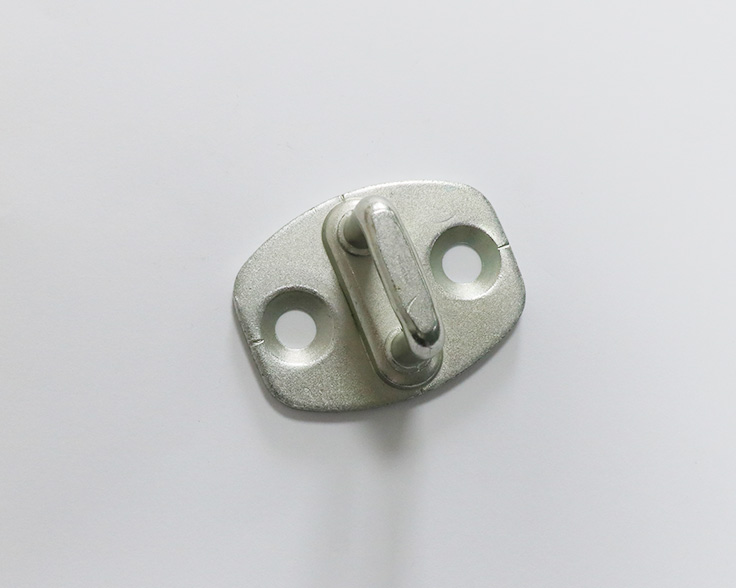(1) Spring blackening process
Alkaline chemical oxidation treatment black, is to process the qualified spring into a solution containing concentrated alkali heat treatment, so that the surface of the spring to obtain a thin layer of dense oxide film, this oxide film has corrosion resistance.
Spring in the heated solution, due to alkali corrosion on the spring surface, iron ions (ferrous compounds) are produced. Adding oxidizer - sodium nitrite to the alkali can change the oxidation process and generate a dense oxide film (ferric oxide) on the spring surface. The oxide film is mainly composed of magnetic iron oxide, and the generation time of the oxide film is 30 to 60 minutes. If the time is prolonged, the thickness of the oxide film cannot be improved. Process:
To the oil -- - (copper) -- - > the pickling - - cleaning - - oxidation (or secondary oxidation) -- - > cleaning - > hot water cleaning - > saponification - - submerged membrane device in oil - - put in storage.
Requirements for each process
Serial number name prescription and technique to be noted
One to remove oil
1. Chemical degreasing NAOH100-150g/L + NA2CO320-27g/L Heating to boiling point Add a small amount of waste acid and iron powder in the barrel
2. Wash the oil with gasoline or diesel.
3. Remove oil and rust by sandblasting or shot blasting
4. The quenched and tempered spring can be rolled to remove oil and rust
Two copper removal with chromic acid 250 ~ 300 g/l + ammonium sulfate 80 ~ 100 g/l without copper can be omitted from this process and water immersion 1 ~ 2 minutes, and then clean in clean water
Three pickling with 30% industrial hydrochloric acid immersion 1 ~ 2 minutes to remove oil and rust pickling time can not be too long four cleaning after cleaning in the weak alkali tank and prevent acid into the oxidation tank
Sodium hydroxide pentoxide 650 ~ 700 g/l + sodium nitrite 100 ~ 150 g/l heating to 140 ~ 144℃, hold for 30 ~ 60 minutes NaoH: NaNO2=5 ~ 8:1
Rinse in flowing clean water after cleaning oxidation
Seven hot water cleaning Hot water 90 ~ 100℃, clean 1 ~ 2 minutes
Eight saponification 10 ~ 20% industrial saponification sheet or triethyloleic acid soap heating 50 ~ 60℃ for 1 ~ 2 minutes the temperature can not be too high
Nine oil immersed MS-1 water film to replace anti-rust oil
Ten in storage

(2) blackening process operating rules
(I) Every day after work, turn on the power supply to heat the tank liquid to the boiling point, and remove the iron oxide (sediment) in the tank;
(ii) Add about 0.5kg of yellow blood salt (potassium ferrocyanide) after removing the sediment;
(iii) Add a certain amount of sodium nitrite according to the technical requirements of the blackening process (in line with 5 ~ 8:1);
(iv) Use a thermometer to measure the humidity of the black tank liquid, ensure that the temperature of the tank liquid 140 ~ 144℃, if the temperature is too high to add water, and control the heating power supply;
(v) Before blackening, the spring must be fully pickled and cleaned, and the tension spring must be vertically framed for easy cleaning;
(Ⅵ) When blackening, the technical requirements must be strictly implemented, the oil residue on the liquid surface should be removed in time, and the tank liquid should be replenished in time;
(Ⅶ) After blackening, the spring shall be sprayed by high-pressure water separation, cleaned by boiling water, and the saponification temperature shall be controlled at 50 ~ 60℃;
(Ⅷ) The spring is framed and stored after draining excess oil. The iron frame with the spring removed must be washed by high pressure water spray before reuse.
After work, add a certain amount of sodium hydroxide to the oxidation tank (conforming to 5 ~ 8:1) and turn off the power supply. Clean and clean the work site, keep the site clean and tidy;
Precautions for blackening process operation
(I) If the oxidized workpiece is found to have yellow frost phenomenon, it indicates that the bath temperature is too high and the water is too little.
(ii) The oxidized workpiece is not black and gray, which is the temperature of the bath is too low or the lack of sodium nitrite.
(iii) The boiling point of the oxidation tank is below 140 ° C to add sodium hydroxide.
(iv) The saponification tank should often be supplemented with saponification tablets or triethyloleic acid soap to maintain a certain concentration.
(V) The oxide film of silicon-containing steel is allowed to be brown or brownish black;
(Ⅵ) When the workpiece blackening quality self-test, should be carried out before the spring oiling process, 2% copper sulfate solution soaking method 30 seconds after no copper precipitation is qualified.
3% copper sulfate drop test. The corrosion test of copper sulfate or 2% copper sulfate is dropped on the workpiece, the workpiece is completely immersed in the copper sulfate solution, and the oxide film does not change color after 30 seconds of naked eye observation. Drop test and etch test are carried out before the workpiece is oiled, and the oil should be removed with alcohol when the finished product is sampled. The blackened and oxidized workpiece will not rust in normal storage for the next year.
2. Phosphating of spring
Phosphating is a process to prevent corrosion of springs in transportation and use. Phosphating springs have corrosion resistance in air, animal and plant mineral oils and organic solvents such as toluene. The spring is suitable for zinc phosphate treatment to avoid hydrogen embrittlement. Phosphating film is thicker than oxide film, generally 5 to 10 microns. Usually phosphating resists corrosion better than oxidation. In particular, phosphating is suitable for the previous process of the spring protection frame.
(1) Spring phosphating process cold water hot water
(1) Oil rust removal - copper removal - cleaning - phosphating - cleaning - passivation - cleaning ———— saponification - immersed film replacement oil - storage
Phosphating process
No. Name technique to be prepared
Oil removal
1. Shot or sandblast to remove oil and rust and oxide for hardening and tempering springs
2. Gasoline washing, can be phosphating after drying (can be washed two or three times) is mainly used for fine springs
3. Chemical degreasing NaoH100 ~ 150 g/l 20 ~ 70%Na2CO2 heating to 100℃
4. Drum to remove oil and rust used for stretching springs
Two copper chromic acid 250 ~ 300 g/l, ammonium sulfate 80 ~ 100 g/l when adding water without copper can be omitted this process
Three clean tap water rinse to remove acid
Ferromangophosphate 30 ~ 35 g/l, zinc nitrate 55 ~ 75 g/l Temperature 70 ~ 80℃ hold for 10 ~ 15 minutes, total acidity 48 ~ 60 free acid 2.5 ~ 6.7 sulfate ≤ 0.5
Rinse with tap water
Six passivated potassium dichromate (K2Cr2O2)80 ~ 100 g/l 90 ~ 100℃ seven clean tap water rinse
Clean hot water 90 ~ 100℃ for 1 ~ 2 minutes
Nine saponification 10 ~ 20 g/l industrial saponification tablets or triethyloleic acid soap 50 ~ 70℃ for 1 ~ 2 minutes
Ten oil soaked film amount oil change
Eleven in storage
(2) Spring phosphorus process operating procedures and precautions
(I) Strictly check the surface condition of the phosphating spring before going to work every day, requiring clean and bright. Do not allow any oil, dirt, rust, copper plating, etc.
(ii) Open phosphating tank, passivation tank, hot water tank. Saponification tank heating power supply, the phosphating tank to ensure that 70 ~ 80℃, passivation tank 90 ~ 100℃, hot water tank 90 ~ 100℃, saponification tank 50 ~ 70℃.
(iii) The material frame used before phosphating is fully sprayed and then loaded into the spring, and the frame must be installed or cleaned polyester and cotton gloves, and there must be no large area or line contact between the springs.
(iv) Strictly implement the phosphating process requirements and hold heat for 10 to 15 minutes when phosphating.
(Ⅴ) The spring after phosphating should be fully washed with tap water.
(Ⅵ) The spring is kept warm for about 1 ~ 2 minutes in the passivation tank, and needs to be fully sprayed with tap water after passivation.
(Ⅶ) Put the spring in the hot sink for 1 ~ 2 minutes, then put it in the saponification tank for 1 ~ 2 minutes, and then send it to the painting place or oil and then send it to the painting place.
(Ⅷ) After work, turn off the power and clean carefully to ensure that the workshop is clean.
(Ⅸ) phosphating tank add ferromangmanganese phosphate and zinc nitrate according to 1:2, the waste potassium dichromate in the passivation tank should be centralized and unified treatment, and the saponification tank should often be supplemented with saponification tablets or tryethyloleic acid soap.
(x) If it is not passivated, operating procedure VI can be omitted.
(3) phosphating quality inspection method (I) soaking method
3% sodium chloride NaCl, temperature 15 ~ 25℃, soaking for 2 hours without rust is qualified.
(ii) One of the drip methods
Copper sulfate CuSO20.5N 40 mg sodium chloride NACL 10% 20 mg, sulfuric acid. 0.1N0.8 mg. The longer the yellow time after drip, the better the quality, and the one who does not change color within 3 minutes is qualified.
(iii) Drop method II
Copper sulfate CuSO4, SH20 66g/l, sodium chloride NACL 32.5g/l, HCL 1:101.2g/L, drip for more than 3 minutes without yellowing is qualified.
(iv) Soaking method
Copper sulfate 5% solution, soaked 1 minute after the surface of the workpiece does not appear yellow is qualified.
At the same time of checking the phosphating quality of the workpiece, the total acidity, free acid and acid radical parameters of the phosphating tank must be regularly tested to ensure the daily phosphating quality of the workpiece.

Mailbox:sales@sz-Zhaoneng,com
Contact number:+86 0512-66707386 +86 15262592017
Add: Building 7, Yajing High-tech Park, 161 Shilin Road, Suzhou New District

